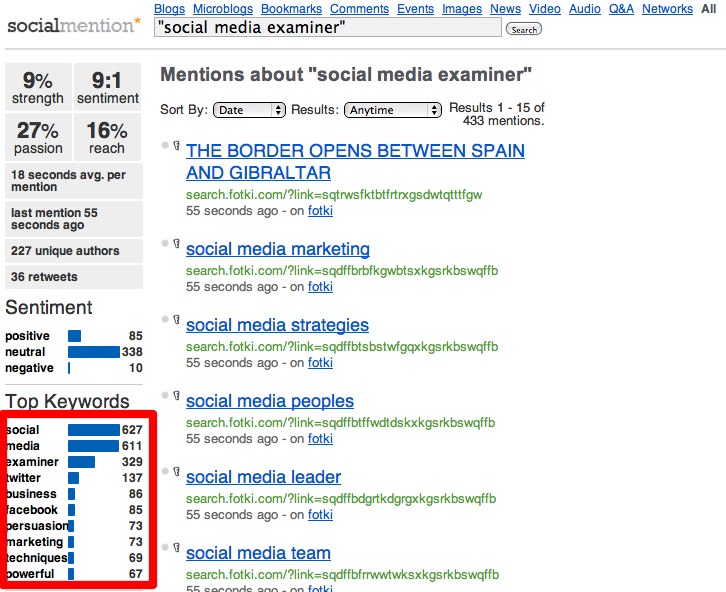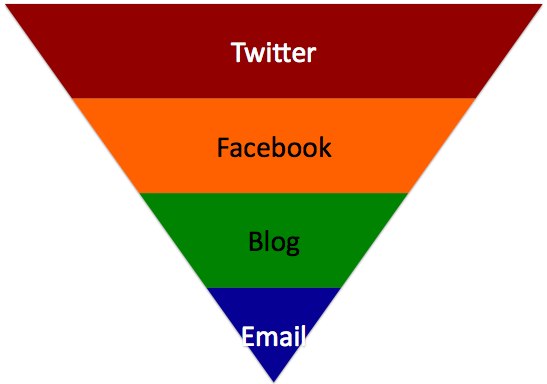 Sure, social media takes a lot of time. Merging Facebook, Twitter and all the other social media options can be challenging. But what if you could cut that time down significantly by cross-leveraging content?
Sure, social media takes a lot of time. Merging Facebook, Twitter and all the other social media options can be challenging. But what if you could cut that time down significantly by cross-leveraging content?
Too many companies are reinventing the content wheel for every social outpost they maintain. A better approach is to create a content ecosystem that allows you to repurpose and cascade your best information.
Instead of a series of self-contained initiatives, build yourself a content ladder.
Here are 5 steps to get there:
#1: Understand Taxonomy
If you want a new pair of glasses, the Yellow Pages is a frustrating neighborhood. Look under “G” for “glasses.” Not found. Look under “E” for “eyeglasses.” Nope. Only when you look under “O” for “optometrists” do you find what you need. It's an example of an industry with poor understanding of taxonomy—the words and phrases used to describe products and services.
Taxonomy is incredibly important in social media because it's the most direct link between the worlds of social and search marketing. Remember, one of your most important customers is Google, and your content ladder needs to maximize your chances for search success.
When creating and promoting social content, include relevant keywords and search phrases wherever possible. (This is especially important now that Google and Bing are incorporating social content into real-time search results.)
Find keywords and search phrases to include in these three places:
Google Analytics (or whatever website analytics program you're using)
Look at your keywords report to find phrases that are driving traffic to your site. I recommend using a mixture of your top 25 phrases and some that are highly relevant to your business, but perhaps aren't sending as much traffic as you'd like at present.
Social Mention (or a paid social media listening package like Radian6, if you have one)
Search for your company or product name (in quotes), and set the pull-down to “all.” You'll then see a search results page that shows a comprehensive list of places you've been mentioned on the social web.

Twitter Lists
How your company or product is referred to in consumer-created Twitter lists can yield important taxonomy insights.
Get World-Class Marketing Training — All Year Long!
Are you facing doubt, uncertainty, or overwhelm? The Social Media Marketing Society can help.
Each month, you’ll receive training from trusted marketing experts, covering everything from AI to organic social marketing. When you join, you’ll also get immediate access to:
- A library of 100+ marketing trainings
- A community of like-minded marketers
- Monthly online community meetups
- Relevant news and trends updates
Go to your Twitter account, click on “listed” next to your followers count and see how the lists that include your Twitter account are named. Consider including some of these phrases to your master keyword list.
Incorporate these phrases into your social content wherever possible, but only when relevant. Nobody appreciates keyword spam on the social web.
#2: Seek Content Inspiration
Creating successful social media content isn't just status updates. Take your top keywords (including your company name, product name, etc.) and search for them on Google, Bing, YouTube, Twitter, Facebook, and Social Mention.

Discover Proven Marketing Strategies and Tips
Want to go even deeper with your marketing? Check out the Social Media Marketing Podcast! Publishing weekly since 2012, the Social Media Marketing Podcast helps you navigate the constantly changing marketing jungle, with expert interviews from marketing pros.
But don’t let the name fool you. This show is about a lot more than just social media marketing. With over 600 episodes and millions of downloads each year, this show has been a trusted source for marketers for well over a decade.
What shows up in these search results? How much photo and video content appears? Content from your competitors? From fans? You'll be amazed at how many content creation ideas this simple exercise can generate.

#3: Understand Your Frequency Ecosystem
The key to a content ladder is organizing your rungs. Your scenario may vary of course, but for illustration purposes let's assume you have a Twitter account, Facebook fan page, blog, and email newsletter.
To create an efficient ladder, you must understand the comparative publishing schedules that you typically employ for each of these outposts. Ordered from most frequent publication to least, let's assume that your program looks like this:

Create your own integrated frequency schedule to better understand how your outposts interrelate.
#4: Test and Track
Create a piece of content (remember to include your key phrases), and post it to the first rung in the ladder (Twitter, in this case). Use a tracking system (I prefer bit.ly) to determine how popular that specific piece of content was with your audience.
Remember, however, that many factors influence popularity at the individual content piece level. Don't make assumptions about these factors, test them. Vary time of day, day of week, phrasing, link placement, and other options and thoroughly document your results.
Social media scientist Dan Zarrella has some excellent research on social content best practices.
#5: Tweak and Repurpose
The content pieces that are most successful on the first rung of your ladder should be appropriately tweaked and redeployed on the second rung of your ladder (Facebook).
Test and track content success on Facebook using bit.ly (or number of likes and comments) and add the most effective content pieces to the next rung on the ladder (blog). Note that as you move down the ladder, your repurposing will be more complex—a blog post requires substantially more content than a Facebook update in most cases.
If a piece of content is successful on your blog (measured by visits as determined by Google Analytics, perhaps), add it to the next rung—your email newsletter.
By understanding how your various social outposts can work together at the content level, you can develop meaningful efficiencies. Also, because a sprinkling of the content included in the lower rungs of your ladder has already proven successful on higher rungs, the relevancy and popularity of your content should increase for most fans/readers/subscribers.
Of course, this content ladder approach assumes that you do not have the exact same audience for each of your social outlets, and I believe that to be an entirely realistic assumption. You may have some overlap (especially with Facebook and Twitter), but consumption of status updates and consumption of blog posts and email newsletters are meaningfully different activities, and attract different groups of fans.
What are your thoughts? Have you tried an approach like this? Please comment below.
Attention Agency Owners, Brand Marketers, and Consultants

Introducing the Marketing Agency Show–our newest podcast designed to explore the struggles of agency marketers.
Join show host and agency owner, Brooke Sellas, as she interviews agency marketers and digs deep into their biggest challenges. Explore topics like navigating rough economic times, leveraging AI, service diversification, client acquisition, and much more.
Just pull up your favorite podcast app, search for Marketing Agency Show and start listening. Or click the button below for more information.

